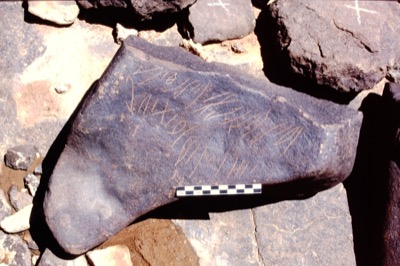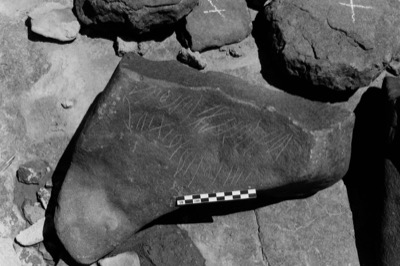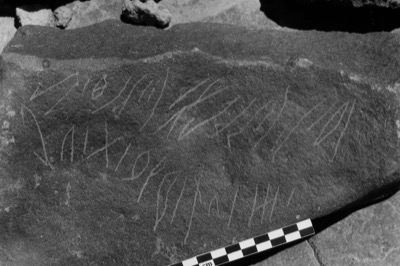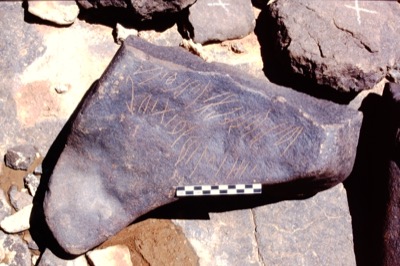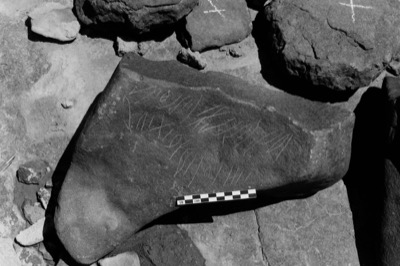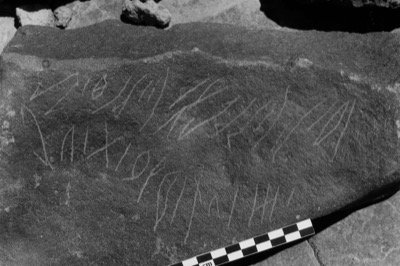Sigla: Is.M 106; LP 424 Script: Safaitic
Transliteration
l mlk bn ġyrʾl bn nhb w nẓr s¹nt ngy mlk s¹lṭn
Translation
By Mlk son of Ġyrʾl son of Nhb and he kept watch the year that Mlk retained power
Apparatus Criticus
LP 424: mn h- s¹lṭn for mlk s¹lṭn
Commentary
The letters are entirely clear and Littmann's reading is impossible. The interpretation of the dating formula is difficult. The simplest translation “the year that Mlk rescued s¹lṭn” is unfortunately unlikely since the use of of the term sulṭān as a personal name is not attested until late in the Islamic period. On the other hand s¹lṭn meaning “imperium” in Safaitic is defined in all other examples except one C 66 where the copy has s¹nt ngy ----m s¹lṭn in which the m is probably the preposition meaning “from” but could be the end of the previous word the rest of which is lost in which case it would provide an exact parallel to our text but would be of no help in elucidating it. In all other cases s¹lṭn is defined and when following the verb ngy it is preceded by the preposition m(n)- (e.g. LP 540 s¹nt ngy m- nmrt h- s¹lṭn). In Arabic and apparently in Safaitic the verb ngy in the I Form means “to be rescued/escape from (mn-) something” and the II Form means “to rescue (someone) from (mn-) something/someone”. We would suggest very tentatively that here ngy mlk means “Mlk was saved” and that s¹lṭn is an adverbial accusative (equivalent to Arabic sulṭānan) “as regards political power”. In this case mlk must be a personal name since if it represented the title “king” it would have to be defined. Given that s¹lṭn seems to be used of state rather than individual power and the fact that the only rulers in the region who we know used the personal name Mlk were the Nabataean kings it is probable that this text refers to one of the Nabataean monarchs of this name either Malichos I (c. 58-30 BC) or Malichos II (AD 40/41-70/71). Malichos II's name was in fact written Mnkw in Nabataean a form which appears in Safaitic in the forms Mk and ʿbd-mk. It is therefore possible that this text refers to one of several known incidents in the reign of Malichos I or one of others unknown. One possibility is the war between Herod the Great and Malichos I in 32/31 BC the final battle of which took place near Qanawāt. According to Josephus Herod at first beat the Nabataeans but the latter were saved at the last minute by Cleopatra's general Athenion who attacked and routed the Jewish army just as it was celebrating victory. Josephus notes that the latter “received a great loss in places where the horses could not be of any service and which were very stony and where those that attacked them were better aquainted with the places than they themselves” (AJ v.1.). Josephus comments “the Arabians [i.e. Nabataeans] had unexpectedly a most glorious success having gained that victory which of themselves they were in no way likely to have gained” (ibid.). On the other hand he gives no indication that loss of this battle would have resulted in the removal of Malichos from power.
Subjects
Genealogy
Country: Syria
Region: Rif Dimašq
Site: Al-ʿĪsāwī
Site number: 15
Map reference: x: 0.297; y: 0.106 (Lambert Syria)
Latitude: 32.903569
Longitude: 37.320314
Present Location: In situ
Find date: 1996–2003
Field collector: Michael Macdonald
Survey: Safaitic Epigraphic Survey Programme (SESP)
Notes: Al-ʿĪsāwī is the name of a probably ancient well between two headlands on the eastern side of the Wādī Shām as it runs northwards from the modern Al-Namārah dam to the Ruḥbah. The well is large, stone lined and with stone water-channels running from it. The main concentration of published inscriptions is on the top of the northern headland, but there also many inscriptions on its south-west slopes, coming down to the well and on the southern headland, on the crest of which is a stone tower.
Associated Remains: None
URL of this record (for citation): http://krc.orient.ox.ac.uk/ociana/corpus/pages/OCIANA_0026876.html
